Table of Contents
What is Protista? – Protista Definition
- A centriole is a tiny, cylindrical organelle that is present in the majority of animal cells. It is formed of microtubules organised in a hollow, cylinder-shaped structure.
- Centrioles are normally situated near the cell’s nucleus, in a region known as the centrosome. They are essential for arranging the microtubules of the cytoskeleton, which are responsible for maintaining cell shape and structure as well as the production of cilia and flagella.
- During cell division, centrioles replicate and migrate to opposite cellular poles to generate spindle poles. The spindle poles are essential for the organisation of the spindle fibres, which are responsible for chromosomal separation during cell division.
- Errors or anomalies in centriole function can result in genetic instability, malformations of development, and illnesses such as cancer.
- Unicellular protists are a large, diversified collection of creatures that inhabit practically all settings and habitats and exhibit a plethora of shapes and forms.
- Hundreds of species of the ciliate genus Paramecium or the flagellated genus Euglena are found in marine, brackish, and freshwater reservoirs; the green algae Chlamydomonas is found worldwide in soil and fresh water; and parasites from the genus Giardia colonise the intestines of numerous vertebrate species.
- Motility is a characteristic shared by these creatures, which is essential for acquiring nutrients and avoiding danger. In the course of evolution, single-celled organisms have developed in a number of ways, resulting in a wide range of swimming styles due to their diverse shape.
- Many swimming protists create thrust by activating tail-like appendages called flagella or cilia. This is accomplished by actively producing deformations along the flagellum, resulting in a complicated waveform.
- The flagellar axoneme is a bundle of nine pairs of microtubule doublets encircling two central microtubules, referred to as the 9+2 axoneme, and cross-linking dynein motors, powered by ATP hydrolysis, perform mechanical work by promoting the relative sliding of filaments, resulting in bending deformations.
- Although protist flagella have a variety of forms and functions, the shape and beating rhythm of their flagella separate two broad families, flagellates and ciliates.
- The branches of the evolutionary tree on the right are coloured blue for aquatic creatures (living in marine, brackish, or freshwater settings) and red for parasitic organisms. Ciliates are denoted by an asterisk following their respective names. The name of each phylum is accompanied with a sketch of a representative organism representing that phylum.
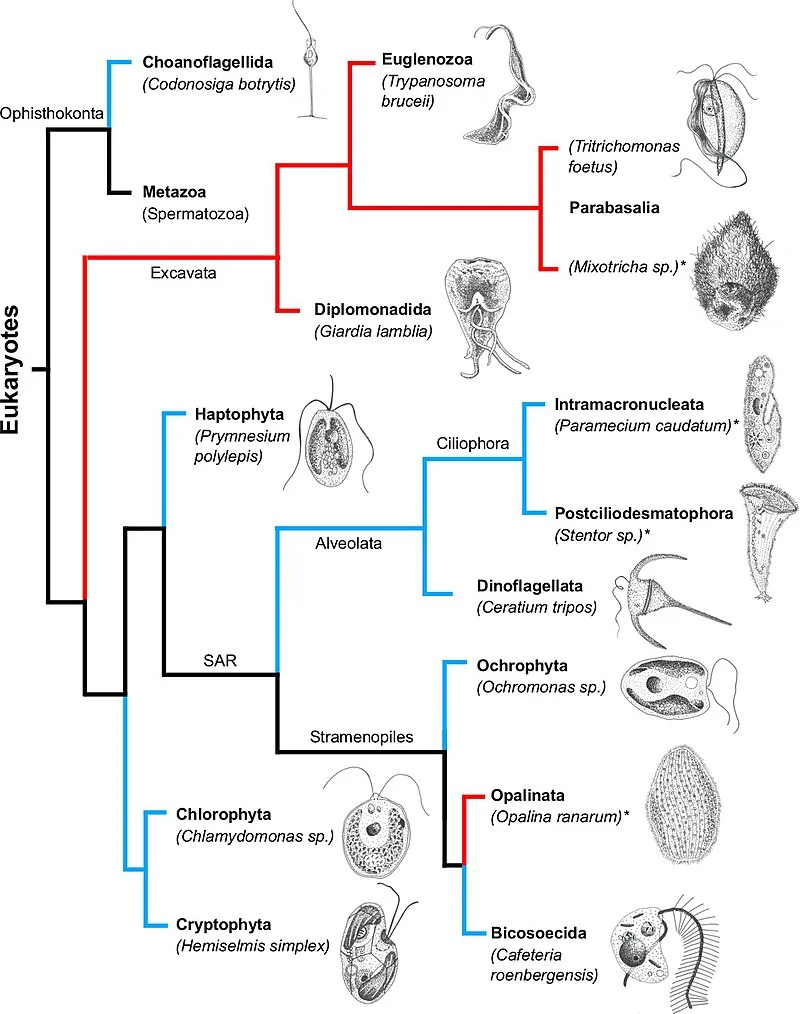
Different Locomotion organs of Protista
Protists are a heterogeneous group of unicellular eukaryotic creatures with a vast array of movement techniques. Certain protists utilise flagella, cilia, or pseudopodia for locomotion.
1. Flagella
Some protists have long, whip-like appendages called flagella that protrude from their surface. They are utilised for propulsion and navigation in fluid situations. Flagella are made of microtubules and can exist individually or in pairs. Euglena, Trypanosoma, and Dinoflagellates are examples of protists that use flagella for motility.
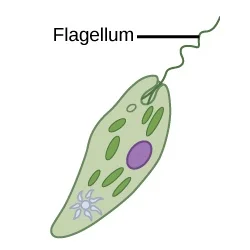
- Both prokaryotes (archaea and bacteria) and protists use flagella. In addition, flagella and cilia are commonly utilised in eukaryotic (plant and animal) cells but not in protist cells.
- The regular beat patterns of eukaryotic cilia and flagella produce cellular motility. Examples include the swimming of spermatozoa and the movement of fluid along a stationary layer of cells, such as in the respiratory tract.
- Although the ultrastructures of eukaryotic flagella and motile cilia are identical, the beating patterns of the two organelles can vary. The motion of flagella is typically flat and wave-like, whereas motile cilia execute a more complex three-dimensional motion with a power and recovery stroke.
- Animal, plant, and protist cell flagella are complex, oscillating cellular appendages. Along with eukaryotic motile cilia, eukaryotic flagella are classified as undulipodia to underline their specific significance as undulating appendages in cellular function or motility. Primary cilia are immotile, and are not undulipodia.
- Typically, flagellates contain a modest number of long flagella dispersed around their body, which they use to create propulsion. The observed movement sequences include planar undulatory waves and moving helical waves, either from base to tip or vice versa.
- Flagella linked to the same body may have distinct beating patterns, resulting in a complex locomotion strategy that frequently depends on the fluid resistance posed by the cell body.
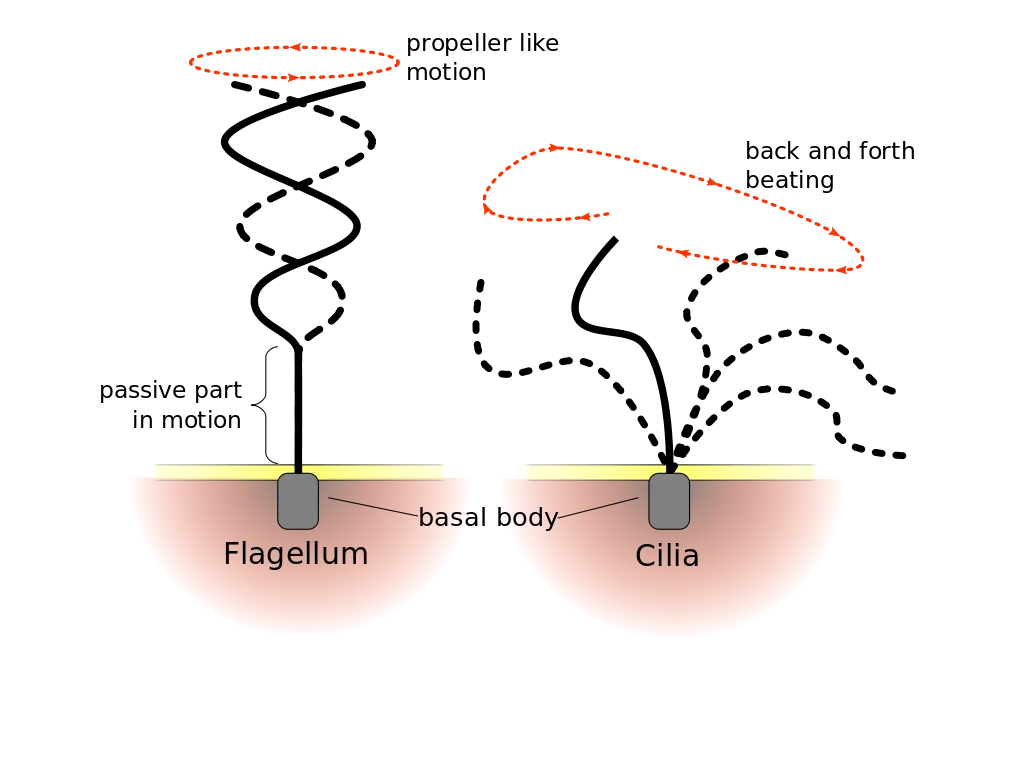
2. Cilia
Cilia are short, hair-like projections found on the surface of certain protists. They are utilised for movement and to generate water currents that aid in the filtration of food particles. Cilia are typically made of microtubules and are abundant on the surface of certain protists. Paramecium, Stentor, and Vorticella are examples of protists that utilise cilia for motility.

- In contrast to flagellates, ciliates are propelled by a coating of tightly packed and collectively moving cilia, which are small flagella resembling hairs and cover their bodies.
- Brennen and Winet’s (1977) seminal review work provides several examples from both categories, stressing their shape, beat form, geometric qualities, and swimming properties.
- Cilia may also be employed to convey the surrounding fluid, and their cooperation can result in the formation of directed flow. This can be essential for internal transport processes in higher species, such as cytoplasmic streaming within plant cells or the transport of ova from the ovary to the uterus in female mammals.
- Cilia are typically composed of hundreds to thousands of cilia arranged in dense arrays. Similarly to flagella, cilia are propelled by specialised molecular motors. The forward stroke is performed with a stiffened flagellum, whereas the backward stroke is performed with a relaxed flagellum.
- An individual cilium deforms during movement as it uses high-friction power strokes and low-friction recovery strokes.
- As numerous cilia are densely packed on a single organism, they exhibit collective behaviour in a metachronous rhythm. This indicates that the deformation of one cilium is in phase with the deformation of its neighbour, resulting in deformation waves that spread across the organism’s surface.
- These waves of cilia allow the creature to move in a coordinated manner through the usage of cilia. The Paramecium, a single-celled, ciliated protozoan coated in thousands of cilia, is a typical example of a ciliated microorganism.
- The 500 micrometres per second swimming speed of the Paramecium is made possible by the cilia beating together.
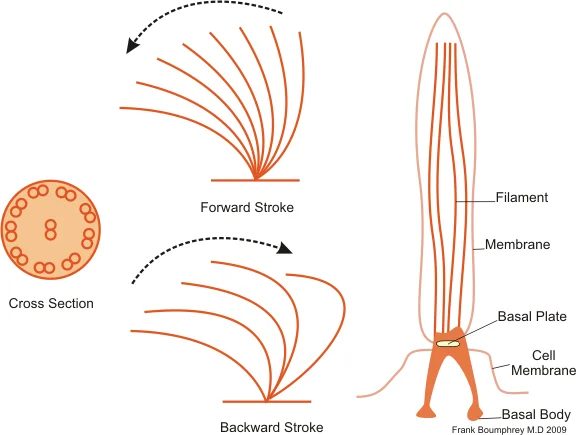
3. Pseudopodia
Pseudopodia are transient extensions of the cell membrane that are utilised for mobility and food capture. They can assume a variety of forms and are typically generated by the protist’s cytoskeleton’s cytoplasmic streaming. Amoeba and Foraminifera are examples of protists with pseudopodia used for movement.
- Pseudopodia are transient extensions of the cell membrane utilised for mobility and food capture in several unicellular organisms, including some protists and some mammal white blood cells. The term “pseudopodia” derives from the Greek for “false feet” because these structures mimic feet or digits that emerge from the cell.
- The cytoplasmic streaming of the protist’s cytoskeleton forms pseudopodia by pushing the cell membrane outward to generate the extension. The cytoskeleton is composed of microfilaments and microtubules, which give structural support and permit the cell to alter form and move.
- The function of pseudopodia differs amongst organisms. Certain protists utilise pseudopodia for locomotion, allowing them to move in a crawling or amoeboid manner.
- The protist extends one or more pseudopodia in the direction of movement, attaches it to the substrate, and then moves the rest of the cell forward by pulling on the pseudopodia.
- Food can also be captured with pseudopodia. Certain protists, such as amoebas, generate a temporary “food vacuole” around food particles by extending pseudopodia around them. The food vacuole is subsequently carried inside the cell, where digestive enzymes decompose it.
- In addition to mobility and eating, pseudopodia can be utilised in animal cell-to-cell communication and the immune system. In the phagocytosis process, white blood cells such as macrophages and neutrophils use pseudopodia to engulf and kill invading pathogens and debris.
- Pseudopodia are a diverse and critical structure that is essential for the survival and mobility of numerous cell types.
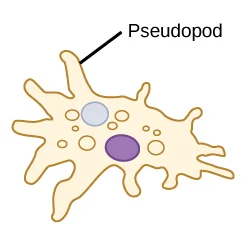
4. Gliding
Certain protists are able to move by gliding around surfaces. This kind of locomotion relies on the release of mucus or the contraction of the protist’s body, as opposed to any apparent appendages or structures. Plasmodium and Phytophthora are two examples of protists that move through gliding.
In conclusion, protists display a wide variety of movement techniques, including flagella, cilia, pseudopodia, and gliding. Each of these techniques has evolved to meet the particular requirements of various protists in their respective settings.
Modes of Locomotion in Protists
These are the five ways of locomotion utilised by Protists. The variants are: 1. Pseudopodial Locomotion 2. Flagellar Locomotion 3. Ciliary Movement 4. Wriggling Locomotion 5. Movement via Mucilage Propulsion
1. Pseudopodial Locomotion
It is a type of slow, creeping locomotion performed with the aid of protoplasmic appendages termed pseudopodia. Both sarcodines and slime moulds utilise pseudopodial movement.
- Certain unicellular organisms, such as amoebas and certain types of protists, employ pseudopodial locomotion to move. This form of cell movement involves the extension of pseudopodia, which are transient extensions of the cell membrane that can be rapidly generated and retracted.
- During pseudopodial locomotion, the protist attaches one or more pseudopodia to the substrate or surrounding media and extends them in the direction of movement. The protist then contracts its cytoskeleton, propelling the remainder of the cell towards the pseudopodia. The protist then detaches the attachment site and extends another pseudopodium in the direction of movement to continue migrating.
- Pseudopodial locomotion enables the protist to move in a crawling or amoeboid manner, which can be advantageous in settings where other modes of locomotion, such as swimming with flagella or cilia, are impractical. Amoebas, for instance, are commonly found in dirt and other substrates, where they extend pseudopodia to crawl across surfaces and gather food.
- Pseudopodial movement is also essential to the animal immune system. During phagocytosis, certain white blood cells, such as macrophages and neutrophils, use pseudopodia to travel towards and ingest invading microbes and debris.
- Pseudopodial locomotion is a diverse and efficient means of movement for numerous cell types, allowing them to explore complicated settings and interact with their surroundings in numerous ways.
Types of Pseudopodia
Pseudopodia are of four types:
- Lobo-podia: These pseudopodia resemble lobes and have broad, blunt tips. They can be found in Amoeba.
- Filo-podia: These pseudopodia are thin, filamentous, tapering, and comprised of ectoplasm. This is present in Euglypha.
- Axo-podia: Long and rigid, with a rigid axial filament. Actinophrys is characterised by these pseudopodia.
- Reticulopodia: They are extensive and branched. The branches of neighbouring pseudopodia are capable of forming a network. They can be discovered in Globigerina.

2. Flagellar Locomotion
- Flagella exhibit a whip-like motion. Typically, they beat independently. Dinoflagellates (e.g., Gonyaulax), euglenoids (e.g., Euglena), and zoo-flagellates utilise this mode of mobility (e.g., Leishmania).
- Certain unicellular species, such as certain types of bacteria and protists, as well as some sperm cells in multicellular organisms, utilise flagellar motility. This kind of locomotion employs flagella, which are long, whip-like appendages that protrude from the surface of the cell and move in a propelling manner.
- Flagellar movement begins with the rotation of the flagellum, which is propelled by a motor protein situated near the flagellum’s base. The flagellum drives the cell through the surrounding media, such as water or mucus, as it rotates.
- The movement direction is determined by the orientation of the flagellum, which may be adjusted to alter propulsion direction. Some cells have a single flagellum that they use to travel in a straight path, but others have several flagella that they can use to move in various directions.
- Flagellar locomotion is an effective form of movement in fluid environments, such as water or mucus, allowing cells to move efficiently across their surroundings. Flagella are found in numerous organisms, including bacteria like Escherichia coli, protists like Trypanosoma and Euglena, and mammal sperm cells.
- In general, flagellar locomotion is a crucial and highly specialised form of movement that is essential for the survival and reproduction of numerous cell types.
3. Ciliary Locomotion
- Cilia exhibit oar-like motion.
- All of a cell’s cilia exhibit coordinated motions of two types: isochronic and metachronic rhythms.
- In isochronic or synchronous rhythm, all of a cell’s cilia beat at the same time.
- In the case of a metachronic rhythm, these events occur in fast succession.
- It is found in ciliates, such as Paramecium.
- Flagella and cilia are essentially structurally identical. Yet, they differ in the ways described below.
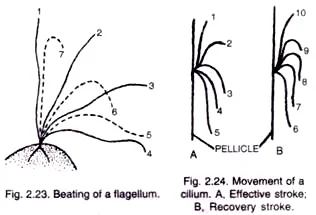
4. Wriggling Locomotion
- It is slow worm-like movement done by a wave of contraction and expansion in the body, exemplified by sporozoans, euglenoids, and organisms without flagella.
- Certain microscopic creatures, including certain types of bacteria and protists, use wriggling locomotion as a mode of movement. This mode of movement is characterised by a writhing or undulating motion of the cell’s body or flagella, allowing it to move through the surrounding media.
- The mechanism of wiggling locomotion involves the contraction and relaxation of the cell’s cytoskeleton, allowing the cell to alter form and move in a writhing or undulating manner. In certain instances, the cell may additionally employ specialised structures such as cilia or flagella to aid in propulsion.
- Small organisms that inhabit fluid environments, such as water or mucus, where the resistance to movement is relatively low, generally adopt wriggling locomotion. It can be an efficient mode of locomotion for these species, allowing them to navigate complicated settings and interact with their surroundings in several ways.
- Some species of bacteria, such as Spirochaetes, which have a helical form and employ writhing locomotion to move through their environment, are examples of creatures that use wriggling locomotion. Certain protists, such as Amoeba and Paramecium, travel through water and collect food particles by wiggling.
- Overall, wiggling locomotion is a specialised and efficient mode of movement for microscopic animals living in fluid environments, allowing them to explore complicated environments and interact in a number of ways with their surroundings.
5. Locomotion by Mucilage Propulsion
- Certain protists, such as diatoms, lack motility organelles. Yet, they can travel from one location to another by secreting mucilage. This form of movement happens in the opposite direction of mucilage secretion.
- Certain microscopic creatures, including particular species of bacteria and protists, use locomotion by mucilage propulsion to move. The cell moves across its environment by secreting and propelling a sticky, gelatinous substance known as mucilage.
- The process of mucilage propulsion commences with the cell’s secretion of mucilage, often from specialised structures known as mucilage glands. The mucilage is subsequently expelled from the cell via specialised structures such as flagella or the contraction and relaxation of the cytoskeleton.
- As the mucilage is expelled from the cell, it adheres to the surrounding medium or substrate, allowing the cell to advance. The cell can then retract the mucilage and continue to move by repeating the procedure.
- Small creatures that dwell in fluid settings, such as water or mucus, where the resistance to movement is relatively low, generally use mucilage propulsion. It can be an efficient mode of locomotion for these species, allowing them to navigate complicated settings and interact with their surroundings in several ways.
- Some bacteria, such as Myxococcus and Bdellovibrio, use mucilage propulsion to travel through their environment. These bacteria secrete and propel mucilage. Vampyrella and other protists utilise mucilage propulsion to move through water and acquire prey.
- Overall, mucilage propulsion is a specialised and efficient mode of locomotion for microscopic organisms living in fluid environments, allowing them to negotiate complicated environments and interact in a number of ways with their surroundings.
MCQ on Protista locomotion
1. Which of the following is a type of locomotion used by protists?
a. Jumping
b. Flying
c. Swimming
d. Crawling
Answer: c. Swimming
2. What is the primary structure used by protists for flagellar locomotion?
a. Cilia
b. Pseudopodia
c. Flagella
d. Contractile vacuoles
Answer: c. Flagella
3. Which of the following protists uses pseudopodial locomotion?
a. Amoeba
b. Euglena
c. Paramecium
d. Plasmodium
Answer: a. Amoeba
4. Which type of protist locomotion involves the secretion and propulsion of a sticky, gelatinous substance?
a. Flagellar locomotion
b. Pseudopodial locomotion
c. Wriggling locomotion
d. Mucilage propulsion
Answer: d. Mucilage propulsion
5. Which of the following is NOT a factor that can affect protist locomotion?
a. Light
b. Temperature
c. Gravity
d. Sound
Answer: d. Sound
6. Which of the following is a characteristic of wriggling locomotion in protists?
a. Use of cilia for propulsion
b. Contracting and relaxing of the cytoskeleton
c. Rapid changes in direction
d. Secretion of a sticky substance
Answer: b. Contracting and relaxing of the cytoskeleton
7. Which of the following is a sensory structure used by some protists for directed movement?
a. Flagella
b. Cilia
c. Pseudopodia
d. Eyespot
Answer: d. Eyespot
8. Which of the following is an example of a protist that uses flagellar locomotion?
a. Amoeba
b. Euglena
c. Paramecium
d. Plasmodium
Answer: b. Euglena
9. Which type of protist locomotion involves a wriggling or undulating motion of the cell’s body or flagella?
a. Flagellar locomotion
b. Pseudopodial locomotion
c. Wriggling locomotion
d. Mucilage propulsion
Answer: c. Wriggling locomotion
10. Which of the following is NOT a method used to study protist locomotion?
a. Microscopy
b. Video recording
c. Computer simulations
d. Radio waves
Answer: d. Radio waves
FAQ
What is locomotion in protista?
Locomotion in protista refers to the various ways in which these unicellular organisms move through their environment, including flagellar, pseudopodial, wriggling, and mucilage propulsion.
How do protists move using pseudopodia?
Protists move using pseudopodia by extending and contracting these temporary projections of their cytoplasm, allowing them to change shape and move forward or engulf food particles.
What is the role of flagella in protist locomotion?
Flagella are long whip-like structures that extend from the surface of some protists and are used to propel the cell through its environment, by rotating in a propulsive motion.
How does wriggling locomotion work in protists?
Wriggling locomotion in protists involves a wriggling or undulating motion of the cell’s body or flagella, allowing it to move through the surrounding medium. This movement is powered by the contraction and relaxation of the cell’s cytoskeleton.
What is mucilage propulsion and how does it work in protists?
Mucilage propulsion is a type of movement used by some protists that involves the secretion and propulsion of a sticky, gelatinous substance called mucilage, which the cell uses to move through its environment.
How do protists change direction during locomotion?
Protists can change direction during locomotion by altering the orientation of their flagella or pseudopodia, or by using specialized structures to change the direction of propulsion.
How does the environment affect protist locomotion?
The environment can affect protist locomotion by altering the resistance to movement and the availability of nutrients and other resources. Some protists are adapted to specific environments and may have specialized locomotion mechanisms to help them navigate through these environments.
Can protists move towards or away from stimuli?
Yes, some protists are capable of moving towards or away from stimuli, such as light or chemicals, by using specialized sensory structures and modifying their direction of locomotion.
Do all protists have the ability to move?
No, not all protists have the ability to move. Some protists are sessile and do not move, while others have very limited movement abilities.
How is protist locomotion studied?
Protist locomotion is studied using a variety of techniques, including microscopy, video recording, and computer simulations. Researchers can also manipulate the environment to study the effects on locomotion, and use genetic techniques to study the molecular mechanisms involved in protist movement.
References
- https://www.stuvia.com/doc/625503/locomotion-and-reproduction-in-protista
- https://www2.gwu.edu/~darwin/BiSc151/Protista/protists.html
- https://www.thebigger.com/biology/kingdom-protista/explain-locomotion-in-protists/
- https://study.com/academy/lesson/3-methods-of-protist-locomotion.html
- https://www.biologydiscussion.com/protists/modes-of-locomotion-in-protists-5-modes/52116
- https://www.aakash.ac.in/important-concepts/biology/protista


